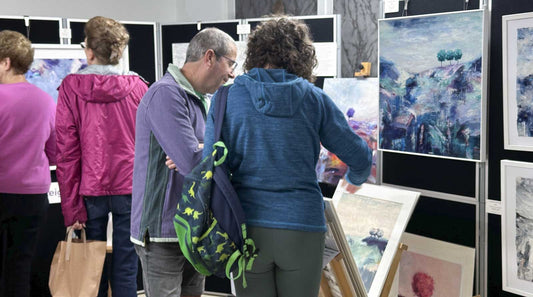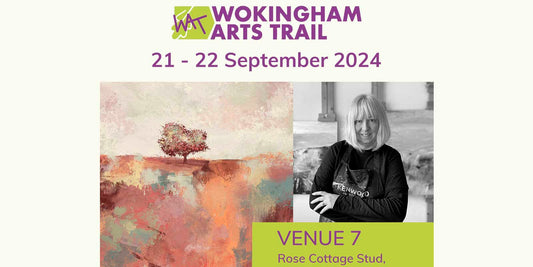
12 essential things you must know before visiting an art fair
Share
How to maximise your time and have fun as an art fair visitor
This list of tips is written from my perspective as a professional artist who regularly shows her work at large art fairs. While I’m talking more about art fairs showing independent artists selling direct (for example Contemporary Art Fairs (Windsor, Surrey, Newbury)), rather than gallery-led shows (such as the Affordable Art Fairs), a lot of these artful tips would apply to either.
With years of experience at showing and selling my work direct to art buyers and collectors at such events, I have met a lot of art fair visitors. And, of course, I'm often on the other side of the fence as an art fair visitor (I have to get my art-fix too!).

Art Fairs may seem intimidating if you haven’t been to one before. You may be concerned that you don’t know enough about art to visit one, or that the art will be ridiculously expensive. Also, due to their scale, and the quantity of artists and work on display, art fairs can sometimes seem overwhelming.
Please stop worrying right now. Art fairs offer an accessible world of creativity and visual magic! They are friendly and relaxed, and offer high quality art to suit most tastes and budgets.
Art fairs don’t need to seem intimidating or be overwhelming if you just follow my few simple tips.
Firstly, imagine an art fair as simply a fabulous room where lots of amazing art is being brought direct to you, in one easy place for your perusal, enjoyment and selection.
Then:
1. Plan your visit to the art fair in advance
Choose a day to visit when you will have plenty of time to spare. There will be a lot of art to see and you don’t want to feel rushed. Don’t miss seeing something special because you’re in a hurry.
2. Make good use of the fair guide/catalogue
Check if the art fair organisers have made their catalogue available online prior to the fair. If they have, this will give you an opportunity to look at the fair layout in advance and to note where any artists of particular interest to you are located. There are often links on the organiser's website to each exhibiting artist’s own website. So you can check them out beforehand.
Using the map provided, choose the path you’re going to follow through the art fair and stick to it. Otherwise, it’s easy to lose track and be distracted by eye-catching art in the next aisle or by a friend trying to pull you in another direction. Or even to forget which rows of stands you’ve already seen or which direction you were going in.

3. Keep an open mind for discovery
Don’t just stick to artists you already know. Who knows what you may discover on your journey round the fair? You may find work you like in a genre you haven’t considered before.
4. See what catches your eye
You won’t be able to look at every painting on every stand since there will be simply too much art for your eyes and brain to take in at once. We all have limited energy and attention spans, even when we’re specifically looking for something to purchase.
It’s a good idea to briefly scan each art stand as you pass. If you don’t like or feel inspired by what you see, don’t stop. Keep moving until work catches your eye and you feel interest or a connection.
5. Talk to the artists
Don’t be shy about talking to the artists that interest you, and asking questions. The artists have invested a lot into being at the fair and will have brought some of their newest and best art to show you. So they will be more than happy to talk to you about it.
You won’t be pressured into buying anything, but you will be given information about the art and what inspired it. And you can ask for help with choosing the right piece if you would like that.
If you’re not planning on buying, or will need more time to make a decision, just be honest with the artist so they know where they stand.
A look behind the scenes at set-up day at Reading Contemporary Art Fair 2018
6. Make notes
In the catalogue, mark off the rows or stands you have visited. But more importantly, use the guide to mark which stands and artists you are interested in. Or take a small notebook or use your phone to write down artist names and stand numbers. Jot down the names of any art pieces you are interested in. It can also be useful to note dimensions and prices if these are of importance in your final decisions.
These notes will help you build a shortlist of artists and works that you want to consider. Then you can go for a coffee to remind yourself of what you have seen and decide what you want to go back for a second look at.
7. Go round again
The second (and maybe even third) time you go round, you will be much more focused. You will be using your shortlist to take another look at all the work you made note of.

8. Comfortable shoes are a must
You will be doing a lot of walking so dress for comfort. Comfy shoes and light layers. Serious collectors are often the ones in trainers! They know!
Don’t forget to take time to re-hydrate and eat. Sometimes you just need to sit down and take a break. Then you’ll be refreshed for another round of art.
9. Remember to bring your dimensions
If you are looking for art for a particular wall, then it’s important that you know the dimensions of the space. Measure in advance and take the information with you. It can be disappointing for both you and the artist if you see a piece you love, but are not then sure whether it will fit.
Having photos of the room on your phone or tablet can also be helpful to any discussion or decision making.
10. Off the wall or bespoke?
If you love the style of work of a particular artist, but don’t see quite the right piece in the selection the artist has with them on their stand, then ask what else they have available at the show. Most artists will have a few extra pieces in reserve in storage, for when work sells during the show. They will be happy to show you.
Ask if they have similar pieces in specific colours or dimensions if that is what you are looking for.
If you want a piece of art that is tailored to your particular requirements, don’t be afraid to ask the artist if they take commissions. Many artists will be happy to create a piece to your required dimensions, colours, etc.

11. Art fair etiquette
There aren't any stuffy rules or pompousness at most art fairs, really just a couple of common courtesies to be aware of.
Always ask permission from each individual artist before taking photos of their work or stand. Some artists don’t mind photographs being taken, but many do mind, for a number of reasons.
Touching the art is generally not permitted or welcomed, particularly on paintings (think sweaty or dirty finger marks, nail scratches, etc.). So, just as you would in a museum or art gallery, restrain your fingers. Or ask the artist for permission first, if the temptation to touch gets too overwhelming.
12. Stay in touch with your favourite artists
We are often wary of giving our email addresses to others, but it is very unlikely that an artist will overload your inbox. What they will often give you, however, is an intriguing insight into their studio life and techniques, advance notification of exciting new work (you'll often get first dibs), free tickets to new art exhibitions, etc.
Just think, from time to time you will receive emails with amazing visual content that you will actually be delighted to see and enjoy.
I hope that you find useful these simple things to think about when visiting an art fair.
Most of all, have a great time visiting and enjoy!
Oh, and if you'd like tickets to my next art fair, sign up just below.




